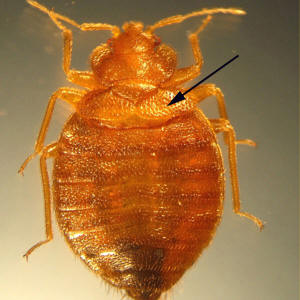 Bedbugs,
those disgusting bugs that scurry out of a mattress or cracks in the wall to
suck human blood in the early morning,
are in the news again, as they are making a resurgence. Home infestations
have skyrocketed. The common bed bug (Latin name, Cimex lectularius) is a
wingless, reddish-brown, blood-sucking human-parasitic insect that grows up to
1/4 inch (7 mm) in length and has a lifespan from several months to more
than 1 year. Bed bugs hide in cracks and crevices in beds, inside mattresses and
box springs, wooden furniture, floors, cracks between floorboards, in walls,
even behind wall outlets during the daytime. They emerge at night to feed on
their preferred host, you and your family! According to Sanitarian Chuck Fisher
in this TV interview,
"The bed bugs have a tendency to climb the walls, move across the ceilings and
drop on you!".
Bedbugs,
those disgusting bugs that scurry out of a mattress or cracks in the wall to
suck human blood in the early morning,
are in the news again, as they are making a resurgence. Home infestations
have skyrocketed. The common bed bug (Latin name, Cimex lectularius) is a
wingless, reddish-brown, blood-sucking human-parasitic insect that grows up to
1/4 inch (7 mm) in length and has a lifespan from several months to more
than 1 year. Bed bugs hide in cracks and crevices in beds, inside mattresses and
box springs, wooden furniture, floors, cracks between floorboards, in walls,
even behind wall outlets during the daytime. They emerge at night to feed on
their preferred host, you and your family! According to Sanitarian Chuck Fisher
in this TV interview,
"The bed bugs have a tendency to climb the walls, move across the ceilings and
drop on you!".
Bed bugs are found worldwide.
Infestations are growing more common in the developing world, especially in
unsanitary living conditions and severe crowding, but starting
in 2001, even in "nice" hotels and airlines. In North America and Western
Europe, strong pesticides, like DDT (now banned) made bed bug infestations rare
during the second half of the 20th century. The
National Pest Management Association reports a 71% increase in calls for bed
bug infestations since 2001.

As mentioned at the outset, the common bedbug is a small (about the size of an apple seed), reddish-brown, flattened bug that looks a bit like a beetle that exclusively feeds on blood of warm-blooded animals, particularly humans, chickens and bats.
They are found in al parts of the world, but hide in cracks, crevices, seams of mattresses, cracks between floorboards, anywhere they can, until the early hours of the morning, when their victims are sound asleep. They then crawl out to feed.
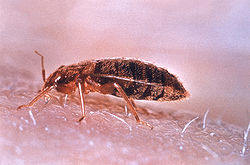
Bedbugs are generally most active just before dawn. Their peak feeding period is about an hour before sunrise. They do feed at other times, too.
If all of this isn't enough to give you insomnia, consider this: they often climb the walls up to the ceiling and then jump down on their human victims, when they feel the warmth of your body and the presence of carbon dioxide rising up.
The bedbug pierces the skin of its host (you) with two hollow tubes.
With one tube it injects its saliva, which contains anticoagulants
and anesthetics, while with the other it withdraws the blood of its
host. After feeding for about five minutes, the bug crawls back to
its hiding place. Normally, the victim won't feel the bites until
minutes or hours later, as the skin reacts to the injected agents.
The first sign of a bite usually comes from the desire to scratch the
bite site.
Although bedbugs can live for a year or as much as
eighteen months without feeding, they typically seek blood every five
to ten days. Bedbugs that go dormant for lack of food often live
longer than a year, well-fed specimens typically live six to nine
months. Low infestations may be difficult to detect, and it is not
unusual for the victim not to even realize they have bedbugs early
on.
Here, at least, is some good news. Although bed bugs could theoretically act as a disease carriers (as is actually the case with body lice and fleas) which transmit trench fever commonly among homeless persons ), bed bugs have never been shown to transmit disease. Hepatitis B viral DNA can be detected in bed bugs up to 6 weeks after they feed on infected blood, but no transmission of hepatitis B has been found. There is currently no scientific evidence that these blood-sucking insects spread diseases such as human immunodeficiency virus (HIV). This means, that while the bugs are disgusting, and may produce allergic reactions in some people, they are no considered to be threatening from a medical perspective.
JAMA tells us to treat the symptoms of the bites using over-the-counter topical antihistamines or topical corticosteroids and topical, oral, or intravenous antibiotics may be required when secondary bacterial infections occur.
UPDATE: In late 2014,
the department of Biostatistics and Epidemiology at the University of Pennsylvania's Perelman School of Medicine, and researchers at
the Universidad Peruana Cayetano Heredia in Peru conducted a series
of laboratory experiments that demonstrated bi-directional
transmission of T. cruzi between mice and bed bugs. The study shows
that bed bugs can transmit a parasite that causes
Chagas Disease. Chagas disease is one of the most prevalent and
deadly diseases in the Americas. And this could make the bed bug may
be just as dangerous as its cousin, the
triatomine, or "kissing" bug.
The triatomine bugs,
which also suck human blood, have long been recognized as vectors of
Chagas disease, which affects 6 to 8 million worldwide, mostly in
Latin America. A handful of
cases have been reported in California and Arizona.The disease
kills about 50,000 a year worldwide. The insects infect people not
through their bite but feces, which they deposit on their sleeping
host, often around the face, after feeding.
The kissing bugs are five times as big as a bed bug, but aside from this, there are many similarities. The researchers say they have established that Bed Bugs theoretically can transmit Chagas Disease. But this has not yet been seen in practice.
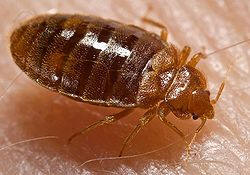
Since bedbugs inject an anesthetic so you won't feel them bite, you generally will only notice their bites after they have gone back into hiding. The bedbug bites usually affect only the surface of your skin, leaving a small itchy red raised mark. Sometimes the bites appear in a line or cluster, when the bedbug feeds repeatedly.
You might find the lesions in a linear or clustered fashion, indicative of repeated feedings by a single bedbug. Patterns of bites in a row or a cluster are typical as they may be disturbed while feeding. Bites may be found in a variety of places on the body.
People who are allergic to the bites may see a reaction in their skin, like larger, itchy bite marks (as big as 6 to 8 inches across - 20 cm), blisters, sometimes filled with pus and other marks of an allergic reaction, like hives.
See this page on the Mayo Clinic website for photos of actual bites .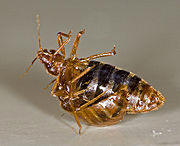
The common bed bug, Cimex lectularius, is the species most adapted to living with humans. Mankind has been bedding down with bedbugs since ancient times, hence the expressions "Sleep Tight and Don't Let the Bedbugs Bite". Other bed bug species feed on bats and birds, especially chickens. The bed bug is wingless, reddish-brown, flattened shaped insect that grows up to 1/4 inch (7 mm) in length. They are sometimes mistaken for ticks or cockroaches. Bed bugs can move rapidly over floors, walls, ceilings and other surfaces (apparently, they have a hard time crawling up smooth metal surfaces, though)
Its lifespan is several months to more than 1 year. Newly hatched nymphs are translucent, lighter in color and become browner as they molt and reach maturity.
Female bed bugs lay their eggs in secluded areas. They deposit 1, 2
or more eggs per day. The eggs are tiny, whitish, and difficult to
see on most surfaces without magnification (individual eggs are about
the size of a pinhead). When first laid, the eggs are sticky, causing
them to adhere to surfaces. Newly hatched nymphs are pale tan-colored
and are no bigger than a pinhead. 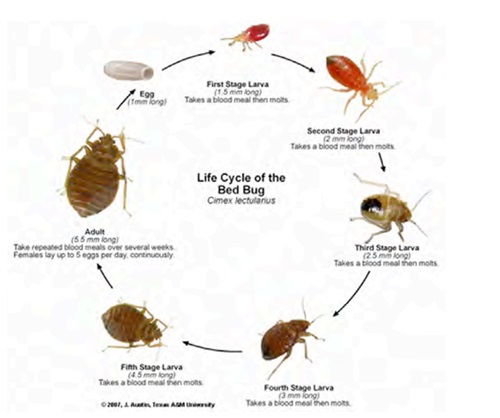 The immature nymphs resemble the
adults, but are smaller and lighter in color. As they grow,
they molt and shed their skin, up to five times before reaching
maturity.
The immature nymphs resemble the
adults, but are smaller and lighter in color. As they grow,
they molt and shed their skin, up to five times before reaching
maturity.
A blood meal is needed between each successive molt. Under favorable temperatures (70-80Â degrees F- 21 - 25 C), the bugs can reach adulthood in as little as a month, producing three or more generations per year. Cooler temperatures or limited access to victims slows their development time. Bedbugs are perversely resilient. Nymphs can survive months without feeding and the adults live for more than a year. Leaving premises unoccupied rarely eradicates an infestation. And although C. lectularius prefers feeding on humans, it will also bite other warm-blooded animals, including dogs, cats, birds, chickens and rodents.
Diseases carries or spread by bed bugs
Here, at least, there is some good news. While bedbugs are disgusting and the cause of insomnia in anyone who has
The bedbugs usually travel in on luggage and other articles carries from an infested area, most commonly a hotel in a developing country, but more frequently, a cheap hotel in the U.S. or Europe and sometimes even very expensive hotels.
It ought to be obvious that you should never take a used mattress, box springs or upholstered furniture from the side of the road, or even buy a used mattress or boxsprings.
Take extreme care in inspecting any used furniture you consider purchasing.
Bedbugs can also enter your house from the outside through cracks and other openings, especially if birds, bats or rodents are nesting nearby.
Bed bugs infest only a small proportion of residences, but they should be suspected if residents complain of bites that occurred while sleeping. The bedroom and other sleeping areas should be carefully examined for bed bugs and signs of bed bug activity. Look under wallpaper, behind picture frames, and inside cracks and crevices near beds. Carefully inspect the bed frame, undersides of windows, door casings, and loose moldings. Folds and creases in the bed linens, and seams and tufts of mattresses and box springs, in particular, may harbor bed bugs or their eggs. They may also be found within pleats of curtains, beneath loose areas of wallpaper near the bed, in corners of desks and dressers, within spaces of wicker furniture, behind cove molding, and in laundry or other items on the floor or around the room. Sometimes, characteristic dark brown or reddish fecal spots of bed bugs are apparent on the bed linens, mattress or walls near the bed. A peculiar coriander-like odor may be detected in some heavily infested residences. Adhesive-based traps used for sampling insects or rodents are not particularly effective for trapping bed bugs.
See this University of Kentucky page for photos of the stains bedbugs leave on mattresses.
One of the newest techniques, and perhaps the most effective, is the use of dogs trained to smell the bedbugs. An article in the the NY Daily News and in the Atlanta Journal Constitution, dated January 11, 2010, Page D1, reports that Quest K9 Detectives is training beagles to find bedbug infestations. At their high Springs training facility (called J & K K9 Academy) they train beagles to be able to inspect up to 120 hotel rooms per day. Trained beagles day inspect 20 fasters than humans, and more accurately and thoroughly.
There are a number of firms popping up around the country offering the services of bed bug sniffing dogs, such as Isotech, a pest control company in Covina, Calif., which has 3 dogs certified by NESDCA to hunt down bed bugs and their eggs at hotels and other locations. National Entomology Scent Detection Canine Association (NESDCA) is the primary organization that certifies dogs and teams.
Pesticides that had been effective against bedbugs (notably, DDT) have been banned, because they were too dangerous for use around humans. The most effective safe and legal remaining methods use heat. And while, we will point out some effective methods for small items, once bedbugs are in your house, you need to call a professional exterminator ensure they are all removed or destroyed.. If you are living in an apartment, condo, or other connected living, the pest control company should inspect all adjacent units.
Bedding, clothing, toys, shoes, towels, sheets, blankets, pillows, pillowcases
Heat works best, and it can be apply wet or dry:
Both methods kill all bed bug life stages, but depend upon the ability of the heat to penetrate evenly to all parts of the materials.
Items which do not fit or otherwise cannot be put in a washer or dryer can sometimes be sterilized by wrapping in plastic and placing them outdoors in a hot, very open sunny location, a hot attic or a hot closed vehicle for at least a day or two. Don't over pack the bags, so the heat can penetrate to all areas.
You may want to use a remote wireless BBQ grill thermometer, with the probe left the the middle of the item, to ensure that the temperatures reach and hold at least 120 to 130 F for a few hours.
Some treatment companies have reported that using industrial heaters to heat the entire interior of a house to 140 F results in almost immediate death of the bed bugs. Of course, team members must go inside the house with thermal problems and ensure that there are no cold spots where bed bugs could hide out the treatment process.
Bed bugs are also killed by cold temperatures (below freezing - 32Â degrees F / 0 C). If you use freezing, it will take longer; the cold must be maintained for several days to be effective.
Integrated Pest Management (IPM)
IPM emphasizes simple, inexpensive practices to prevent infestations without the use of pesticides that harm to people and the environment. IPM focuses on eliminating the root cause of pests by eliminating or reducing their access to food, water and hiding places.
Cornell has a factsheet: "Best Management Practices for Controlling Bed Bugs; An Integrated Pest Management Approach"
House cleaning, such as vacuuming floors, wiping surfaces, rarely is successful as you cannot reach the places where bed bugs hide.
Consumer pesticides are ineffective. In fact, many of the professional insecticides that even work on cockroaches, are ineffective on bedbugs. The really effective ones (like DDT) have been banned by the EPA (for the obvious reasons of their toxicity to humans and the environment)
For this reason, it may be more practical to throw out infested items, especially mattresses, boxsprings and bulky items like upholstered furniture.
Number on the list of means to prevent a bedbug infestation is to avoid traveling to undeveloped countries, and to avoid staying in hotels. Studies claim that bedbugs are more prevalent in cheap (less than $50 per night) hotels and motels) a fact that may make even Clark Howard consider upgrading to better hotels. According to ABC news, University of Arizona microbiologist Charles Gerba, PhD, aka "Dr. Germ," says "I did a study about seven years that found if you paid more than $50 a night, there was a much greater chance that the room was regularly disinfected. Rooms under $50 weren't."
There are more that 18,000 pest management firms in the United
States. Here's how to find the best company in your area:
Additional Resources: To Make Finding Your Way Easier
As you have probably
gathered, selecting an appropriate pest management firm that is
capable of effectively treating for bed bugs can be difficult.
Bedbugs are a persistent, difficult to eradicate pest that feed on humans, but do not spread any known diseases. Eradication is usually difficult and expensive ($10,000 to $50,000 for a house). Prevention by inspecting any hotel room in which you stay and not buying used beds and mattresses is the best defense.
Top tips:
Virginia
Charlottesville, VA - News story about bed bugs in Charlottesville hotels and motels
The
Ways to save money AND help the environment:
Eat healthier AND save money: Instant Pot Duo Crisp 11-in-1 Air Fryer and Electric Pressure Cooker Combo with Multicooker Lids that Fries, Steams, Slow Cooks, Sautés, Dehydrates
Save water AND money with this showerhead adapter, it lets the water flow until the water is hot, then shuts off water flow until you restart it, ShowerStart TSV Hot Water Standby Adapter
Protect your health with these:
Mattress Dust mite-Bedbug protector, 100% Waterproof, Hypoallergenic, Zippered
Handheld Allergen Vacuum Cleaner with UV Sanitizing and Heating for Allergies and Pet, Kills Mite, Virus, Molds, True HEPA with Powerful Suction removes Hair, Dander, Pollen, Dust,
Immune Support Supplement with Quercetin, Vitamin C, Zinc, Vitamin D3
GermGuardian Air Purifier with UV-C Light and HEPA 13 Filter, Removes 99.97% of Pollutants
5 Stage Air Purifier, Features Ultraviolet Light (UVC), H13 True Hepa, Carbon, PCO, Smart Wifi, Auto Mode, Quiet, Removes 99.97% of Particles, Smoke, Mold, Pet Dander, Dust, Odors
Interesting Reads:
THE PREPPER'S CANNING & PRESERVING BIBLE: [13 in 1] Your Path to Food Self-Sufficiency. Canning, Dehydrating, Fermenting, Pickling & More, Plus The Food Preservation Calendar for a Sustainable Pantry
The Backyard Homestead: Produce all the food you need on just a quarter acre! Paperback
The Citizens' Guide to Geologic Hazards: A Guide to Understanding Geologic Hazards Including Asbestos, Radon, Swelling Soils, Earthquakes, Volcanoes
The Uninhabitable Earth: Life After Warming
Book: The Sixth Extinction: An Unnatural History Paperback